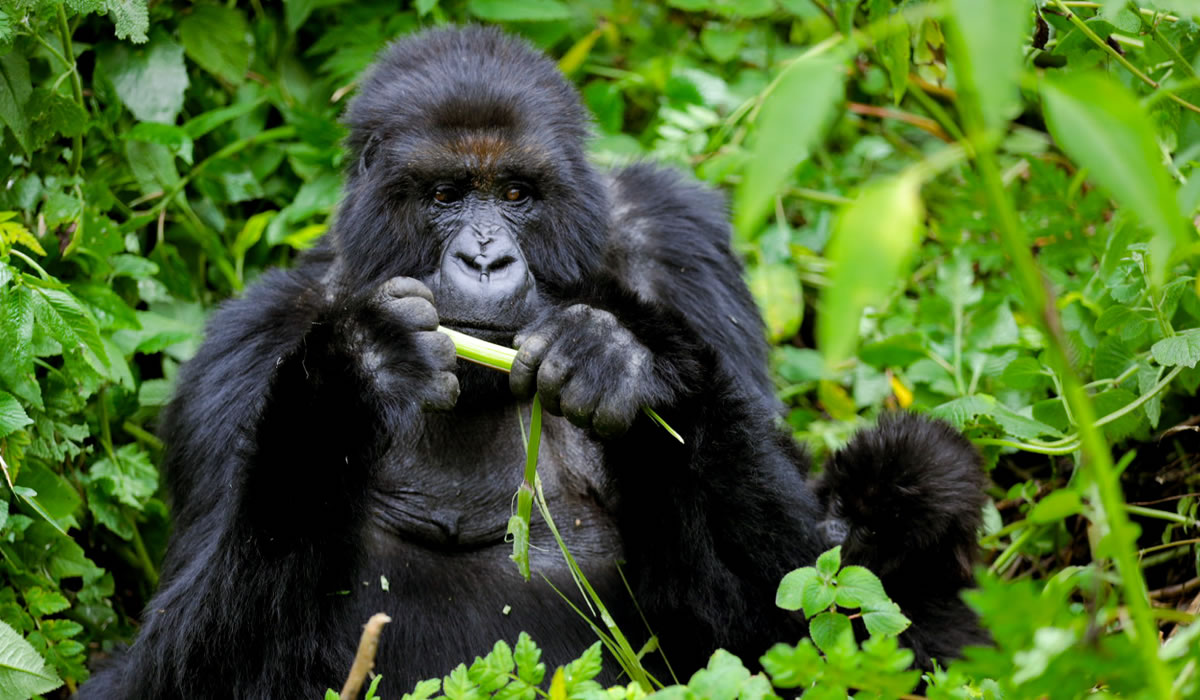Located in the northwest of Rwanda, along the borders with Uganda and the Democratic Republic of Congo, Volcanoes National Park is a breathtaking expanse of mist-covered mountains and rich biodiversity. Covering an area of approximately 160 square kilometers, the park is part of the larger Virunga Massif, a chain of eight volcanic mountains that stretch across the three countries. Five of these volcanoes; Karisimbi, Bisoke, Muhabura, Gahinga, and Sabyinyo lie within the park, forming a dramatic backdrop to one of the most important conservation areas in Africa. But what truly sets Volcanoes National Park apart is its status as a sanctuary for the endangered mountain gorilla, immortalized by the legendary primatologist Dian Fossey, who spent nearly two decades studying and protecting these gentle giants.

Things to See in Volcanoes National Park
The main draw to Volcanoes National Park is undoubtedly its mountain gorillas. With only about 1,000 mountain gorillas remaining in the wild, and a significant portion of them residing within the Virunga region, a visit to the park offers a rare and humbling opportunity to observe these incredible creatures in their natural habitat. Gorilla families in the park are habituated, meaning they are accustomed to human presence, allowing for an up-close and respectful viewing experience under the guidance of trained trackers and rangers.
Beyond gorillas, the park is also home to golden monkeys, another species endemic to the Albertine Rift. These playful and brightly colored primates live in the bamboo forests at the base of the volcanoes and are a delight to watch as they leap between trees and forage on the forest floor.
Volcanoes National Park is a haven for birdlife as well, with over 200 species recorded, including several Albertine Rift endemics such as the Ruwenzori turaco, dusky crimsonwing, and handsome francolin. The park’s diverse ecosystems—from bamboo forests and open grasslands to alpine meadows—support a wide array of flora and fauna, creating a dynamic and vibrant environment that is always full of life.
In addition to its natural wonders, the park is rich in cultural and historical significance. Visitors can explore the Dian Fossey Tomb and Research Center, located between Karisimbi and Bisoke, where the pioneering scientist conducted her groundbreaking research on mountain gorillas before her untimely death in 1985. Her legacy lives on in ongoing conservation efforts and through the Ellen DeGeneres Campus of the Dian Fossey Gorilla Fund, a new state-of-the-art research and education facility near the park.
Activities in Volcanoes National Park
1. Gorilla Trekking
The most iconic and sought-after activity in Volcanoes National Park is gorilla trekking. Each day, a limited number of visitors (typically 96 people, divided into groups of 8) are permitted to trek to one of the habituated gorilla families. The experience begins early in the morning with a briefing at the park headquarters in Kinigi, followed by a guided hike through the forest to locate the gorillas.
The trek can take anywhere from 1 to 5 hours depending on the location of the gorilla group, and the terrain can be steep and muddy. However, the reward is unparalleled: spending an awe-inspiring hour observing a gorilla family as they go about their daily routine; playing, grooming, feeding, or simply lounging—is a life-changing experience that few ever forget.
2. Golden Monkey Tracking
Less strenuous and more playful, golden monkey tracking is a shorter excursion that also begins at the Kinigi headquarters. Visitors hike into the bamboo forests where troops of golden monkeys reside. These primates are quick, agile, and entertaining to watch, making the experience ideal for families or those who want an alternative to the longer gorilla trek.
3. Volcano Hikes
For the more adventurous, several of the park’s volcanic peaks are accessible for hiking. Mount Bisoke, known for its stunning crater lake at the summit, is the most popular one-day hike. The trek typically takes 6 to 7 hours round trip and offers spectacular views, diverse vegetation zones, and occasional wildlife sightings.
Those looking for a more challenging experience can attempt Mount Karisimbi, the highest of the Virunga volcanoes at 4,507 meters. This is a two-day trek involving camping overnight near the summit, and it requires good physical fitness, but the views and sense of accomplishment are well worth it.
4. Dian Fossey Hike
The trek to the Dian Fossey tomb and former Karisoke Research Center is a fascinating hike that combines nature, history, and conservation. Lasting about 3 to 4 hours, the hike takes visitors through bamboo forests and up into the saddle between Mount Karisimbi and Mount Bisoke. Along the way, guides share stories of Fossey’s life, work, and the challenges of protecting gorillas from poachers.
5. Cultural Experiences
Visitors can also immerse themselves in local Rwandan culture through guided community visits. The nearby Iby’Iwacu Cultural Village, now known as the Gorilla Guardians Village, offers a chance to experience traditional music, dance, and crafts, as well as interact with former poachers who now work as conservation advocates and cultural performers.
Best Time to Visit
Volcanoes National Park can be visited year-round, but the best times to visit are during the dry seasons, which run from June to September and mid-December to February. During these months, the trails are drier and more accessible, making trekking less challenging and improving visibility for wildlife sightings.
The wet seasons from March to May and October to mid-December see heavier rainfall, which can make trekking more difficult due to slippery paths. However, the park is lush and green during these periods, and fewer tourists mean a more private experience. It’s also a great time for photography, as the misty mountains create atmospheric scenes.
No matter the season, it’s important to dress in layers and be prepared for sudden weather changes. The high-altitude environment means temperatures can be cool, especially in the early mornings and evenings.
How to Get There
Getting to Volcanoes National Park is relatively straightforward, especially from Rwanda’s capital, Kigali. The park’s main gateway is the town of Musanze (formerly Ruhengeri), which is located about 110 kilometers from Kigali a journey of approximately 2.5 to 3 hours by car on paved roads. The park headquarters in Kinigi, where all treks and activities begin, is just a short drive (about 15 minutes) from Musanze.
Visitors can reach the park via private vehicle, tour operators, or car hire services from Kigali. Several tour companies also offer all-inclusive safari packages that include transportation, accommodation, and park permits.
For those seeking a faster and more scenic option, helicopter transfers are available through services such as Akagera Aviation, offering aerial views of Rwanda’s hills and volcanoes.
Accommodation Options
A wide range of accommodation is available near Volcanoes National Park, from luxury lodges to budget guesthouses. High-end options include Bisate Lodge, Sabyinyo Silverback Lodge, and One&Only Gorilla’s Nest, offering top-tier service, gourmet meals, and exclusive experiences. These lodges are often situated on hillsides, with panoramic views of the volcanoes and surrounding countryside.
Mid-range options include Mountain Gorilla View Lodge and Le Bambou Gorilla Lodge, which provide comfortable amenities and close proximity to the park. Budget travelers can find simple but cozy accommodations in Musanze, such as Amahoro Guest House or Fatima Hotel.
Volcanoes National Park is not just a place; it’s a profound experience. It’s where ancient volcanoes pierce the sky, dense rainforests hide endangered species, and the deep connection between humans and nature comes vividly to life. Whether trekking through misty forests in search of gorillas, standing at the edge of a crater lake, or listening to the traditional drums of a local village, visitors to Volcanoes National Park leave with lasting memories and a renewed appreciation for the natural world. As Rwanda continues to lead in conservation and sustainable tourism, this park remains a shining example of how ecotourism can benefit both wildlife and people, preserving a global treasure for generations to come.

